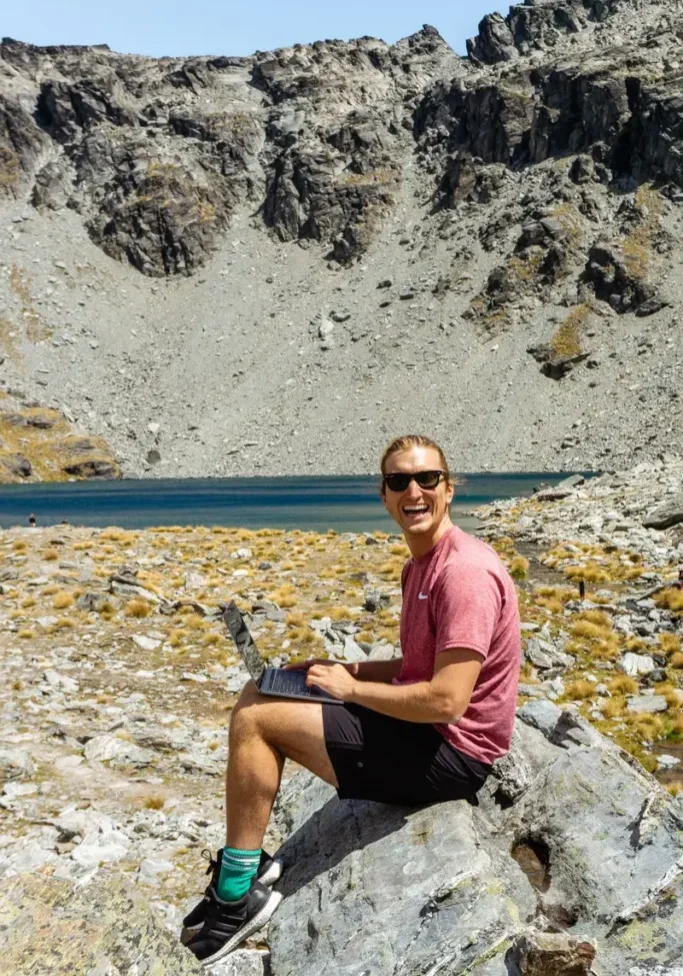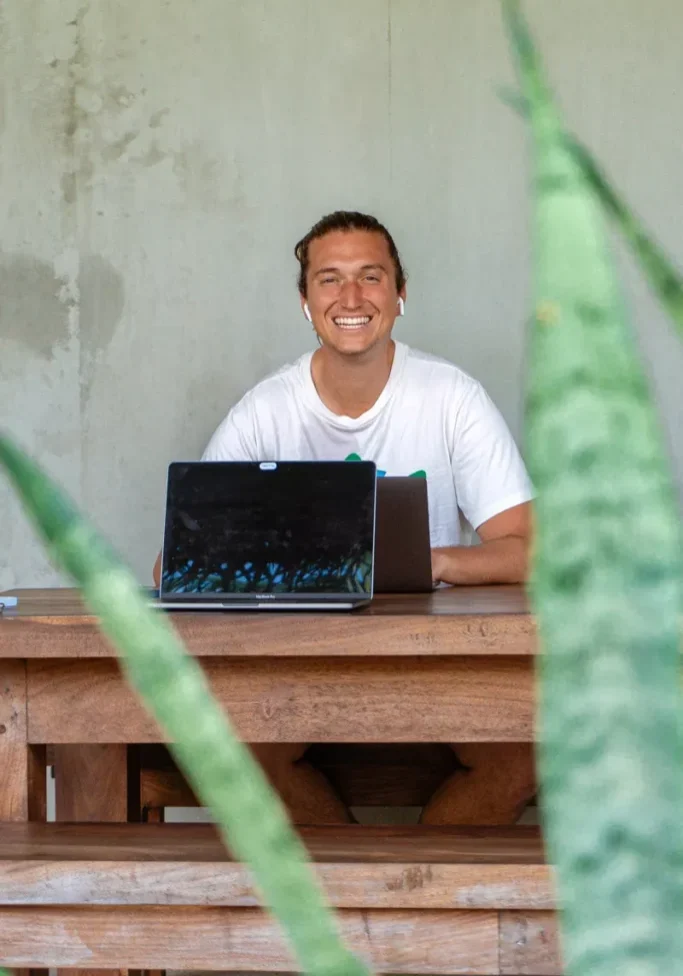Sri Lanka is becoming more and more of a digital nomad destination because of the awesome weather, chill vibes, beautiful sunsets, fresh fruit, friendly locals, and all the awesome things you can do around the country.
After spending almost a month in this beautiful country, we’ve put together this guide on the ins and outs of everything you need to know about being a digital nomad in Sri Lanka – from where to stay, what to expect, and other things you need to know before coming here as a digital nomad.

Whether you’re a seasoned nomad who has been doing this for years or someone who is just starting out working remotely, you really can’t go wrong with Sri Lanka.
This country has the perfect balance of cute cafés with (distracting but) beautiful views + fast wifi, nice affordable accommodation, and a ton of fun things to do when you’re not on your laptop.
As a digital nomad destination, Sri Lanka has so much to offer! We’re excited to dive into this awesome country and share everything you need to know before coming to the Pearl of the Indian Ocean.
Disclaimer: This post contains affiliate links which means if you decide to use the links and make a valid purchase, we will receive a small commission at no additional cost to you. Thank you for your support!
All you need to know about being a Digital Nomad in Sri Lanka
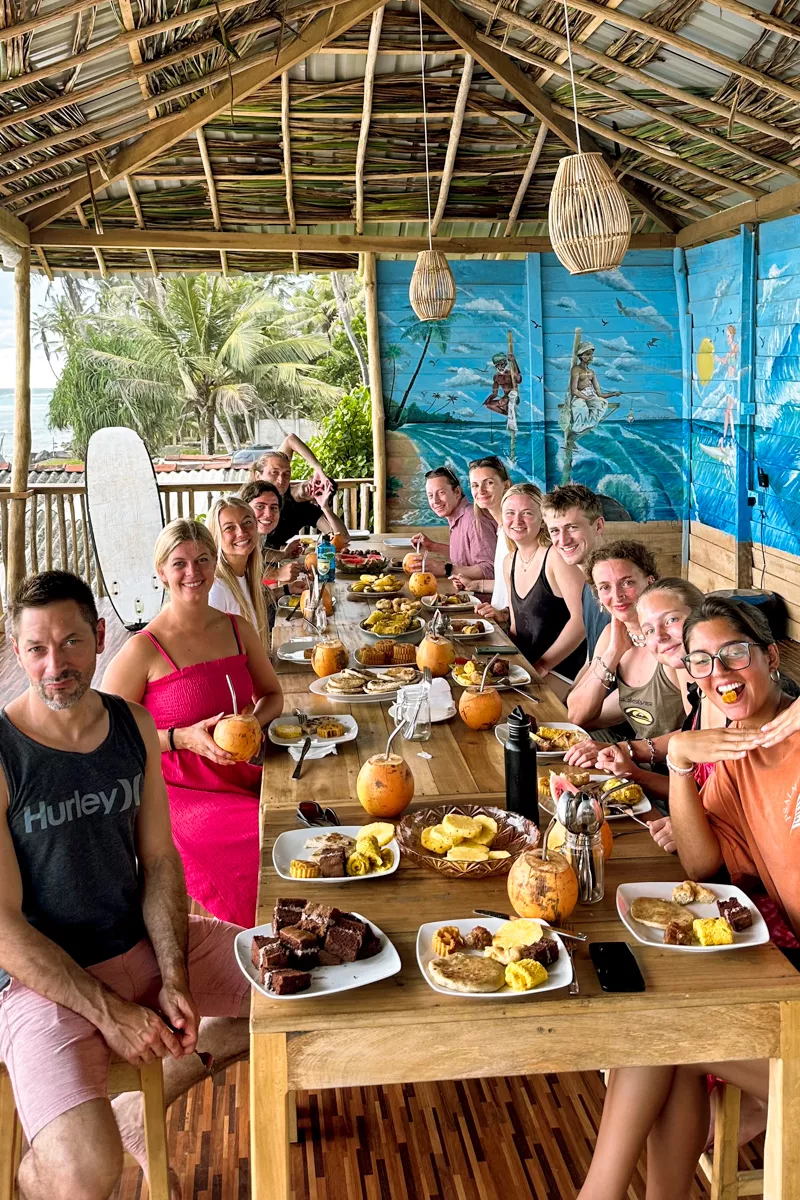


Before going to Sri Lanka
First things first! Before heading to Sri Lanka, there are a bunch of things you need to get sorted. I’m sure we can agree that it’s great to have those things done with so you can focus on being excited for your trip & enjoy your time once you’re there!
In this section, we’ll cover travel insurance, getting an eSIM so you can stay connected, safety & scams to look out for, and visas.
Get digital nomad travel insurance
We never head off on a trip without travel insurance – especially when we’re living the digital nomad life full-time.
We’ve been travelling for almost a decade now, and SafetyWing is the one we always recommend to family and friends! It’s the one we’ve found to be the most reliable digital nomad insurance for the best price (we’ve done a comparison between SafetyWing and WorldNomads here).
SafetyWing is created specifically for digital nomads, which means it’s super flexible (you can even sign up after leaving your country of residence) and it covers a wide range of activities – including surfing!
Plans start at just $2 a day and include both travel and health coverage, which is pretty amazing considering the price. Check out SafetyWing here and see if it’s the right fit for you!
Get an eSIM for Sri Lanka
One thing that’s super helpful to have during your time in Sri Lanka is an eSIM. It’s not uncommon to have power cuts in Sri Lanka, so by having an eSIM, you can stay connected and keep up with your work if this happens!
We personally have European phone plans, so every time we leave the continent, we buy an eSIM. It’s so easy, and this way, we don’t have to keep track of where our European sim is while we’re gone, as we would if we were to get a physical sim card!
One of the best parts of eSIMs is that you can purchase them beforehand, and the minute you land, you can turn it on and you’ll be able to use it. It’s so convenient.
Nowadays, there are quite a few different apps and companies you can go with for eSIMs. We recommend Nomad or Airalo, which are both great eSIM companies. eSIMs will make your life a lot easier when it comes to communication and having the internet as soon as you get somewhere.
📞 You can get an eSIM for Sri Lanka for just $6.5 a month 🇱🇰
Safety and scams to look out for
Since Sri Lanka has been in the news quite a few times over the years due to political unrest and other things, we thought we’d dedicate a little section to safety and scams.
First off, we want to stress that at no point during our three weeks in Sri Lanka did we feel unsafe. Everyone we met was kind, friendly, and helpful – and we felt safe the entire time we were there!
That being said, there are a few things you should look out for when you’re there. The most common incidents we heard of were ATM scams, tuk-tuk drivers trying to overcharge you, and traffic accidents with the buses.
Common sense goes a long way, but should you ever need help, these are the phone numbers for the emergency services:
- Police: 118/119
- Ambulance: 110
While we hope you never have to use them, you can add them to your contacts so you have them just in case.
As we mentioned before, one of the biggest “scams” you’ll face on the island is simply tuk-tuk drivers trying to overcharge you.
The best way to avoid this is once you get to your accommodation, ask the staff members roughly how much a tuk-tuk ride should cost.
In general, though, you shouldn’t pay more than 100 Sri Lankan Rupees (0.3 Euro) per kilometre. Agree on the cost with the driver before getting into the tuk-tuk and negotiate a return price to lower the cost.
The surf camp we stayed at also advised against taking a tuk-tuk alone at night.
Visas for Sri Lanka
We are by no means visa experts, but we can at least guide you in the right direction. For this kind of stuff, we always suggest you look on your government website to see the most recent and up-to-date information on visas for the specific country you’re travelling to.
Most people travelling to Sri Lanka need a visa, which you can technically get upon arrival – however, you do need to pre-apply for an ETA (Electronic Travel Authorization) before arriving in Sri Lanka.
The ETA costs $50 US (unless you’re from a South Asian country, SAARC. In that case, the price is $30. It usually takes up to a few days for the ETA to get approved, so don’t wait till the last minute to apply.
You can apply for your ETA on Sri Lanka’s ETA website here (and yes, this is the official website, even though it might not look like it!). You can also read more about the specific visa, criteria, etc for Sri Lanka there.
Visas can be a pain to sort out, but it’s best to do your research and do it right so there are no issues once you’re arriving in the country!
Some important things to note with regard to the visa & ETA:
- The ETA is valid for 30 days after arrival in Sri Lanka
- Your passport must be valid for at least 6 more months from the date of arrival
- Upon arrival, you should be able to prove:
- A round-trip ticket to show at the port of entry in Sri Lanka
- Evidence of sufficient funds to cover your expenses in Sri Lanka
- You can apply via Sri Lanka’s ETA website here
Best places to stay for Digital Nomads
Digital nomads tend to gravitate towards the same places, and in Sri Lanka, this is no different! Most digital nomads like to hang out down on the south coast in the areas between Ahangama and Hiriketiya.
This is also the area we stayed in when we went to Sri Lanka and stayed at a surf camp (so much fun!).
The most popular spots to visit on the south coast (and for nomads) are Ahangama, Weligama & Mirissa, and Hiriketiya. And then on the south-east coast, you will also find Arugam Bay, which is another popular digital nomad hotspot.
You can see the different spots on the map above, and below we’ve listed out the best things to do + where to stay in each of the destinations!

Ahangama, Weligama & Mirissa
These three towns are all well-known for their beach and surf culture (as are a lot of the digital nomad hotspots in Sri Lanka).
We’ve included them together here since they’re all located on the southern coast of the country, only 15 minutes from each other. You’ve got Ahangama to the West, then Weligama in between the two, and Mirissa to the East.
Things to do in Ahangama, Weligama, and Mirissa
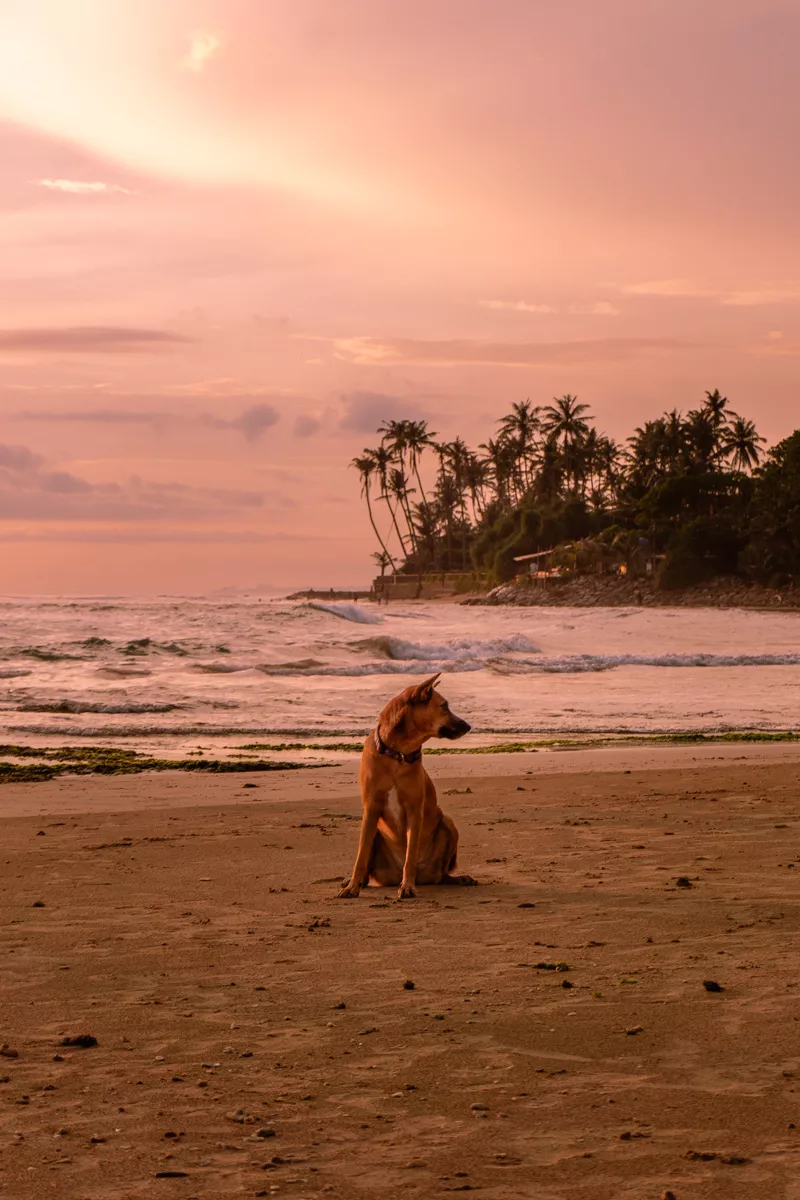

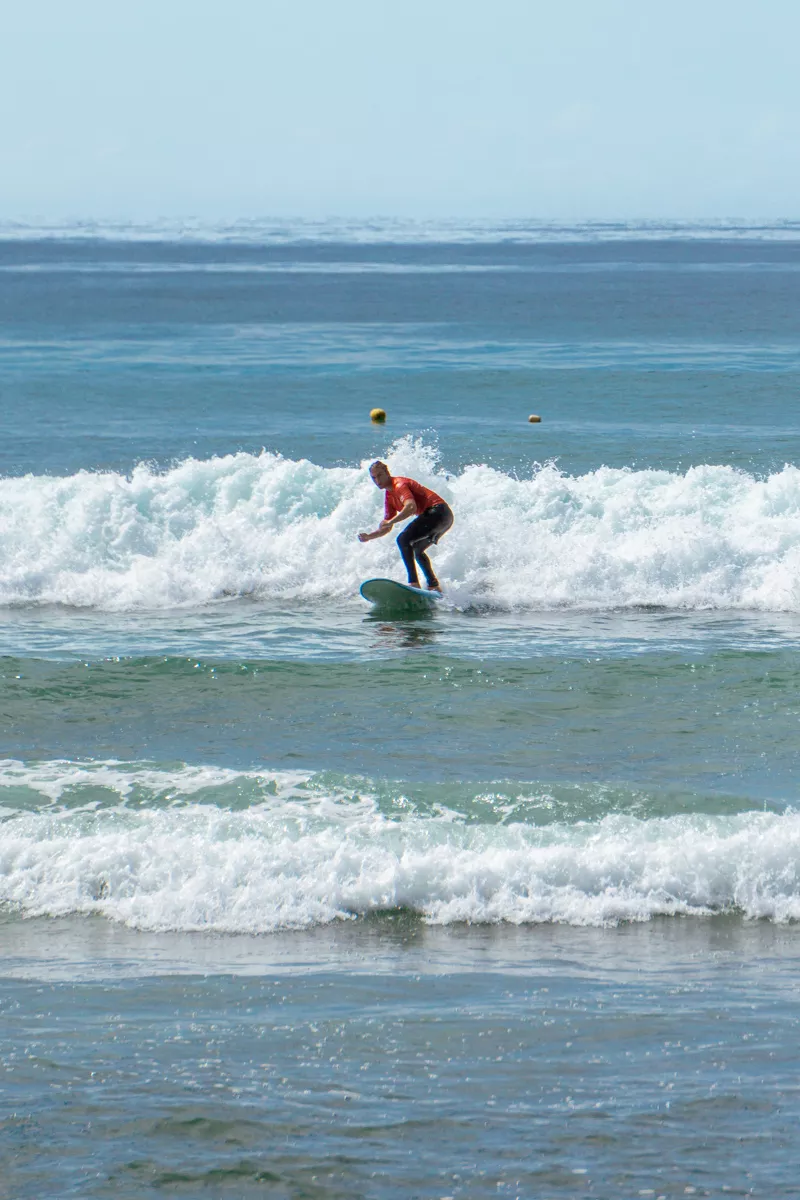
Ahangama, Weligama, and Mirissa are a little piece of paradise for digital nomads!
In these towns, they have everything from local restaurants and cute little cafes you can work from to nice, modern accommodation and beautiful coastlines where you can catch some waves after work.
This part of the south coast offers a good mix of tourists and locals, and it’s one of the best places in Sri Lanka if you want to experience the local culture while keeping the comfort of Western culture.
Overall, we found that Mirissa was a great place for backpackers, cute cafés, parties, and surfing. Weligama was a bit more rustic with lots of beginner surfing. And then Ahangama had a bit more of a town vibe with better surf (including a lot of surf camps), cafés to work from, and beautiful sunsets.
Overall, we preferred Ahangama for digital nomads & surfing and Mirissa for its beautiful beaches & coconut hill. Weligama was our least favourite of the three.
That being said, we found all three towns to be fairly similar, and no matter where you decide to stay, we’re sure you’ll have a great time!
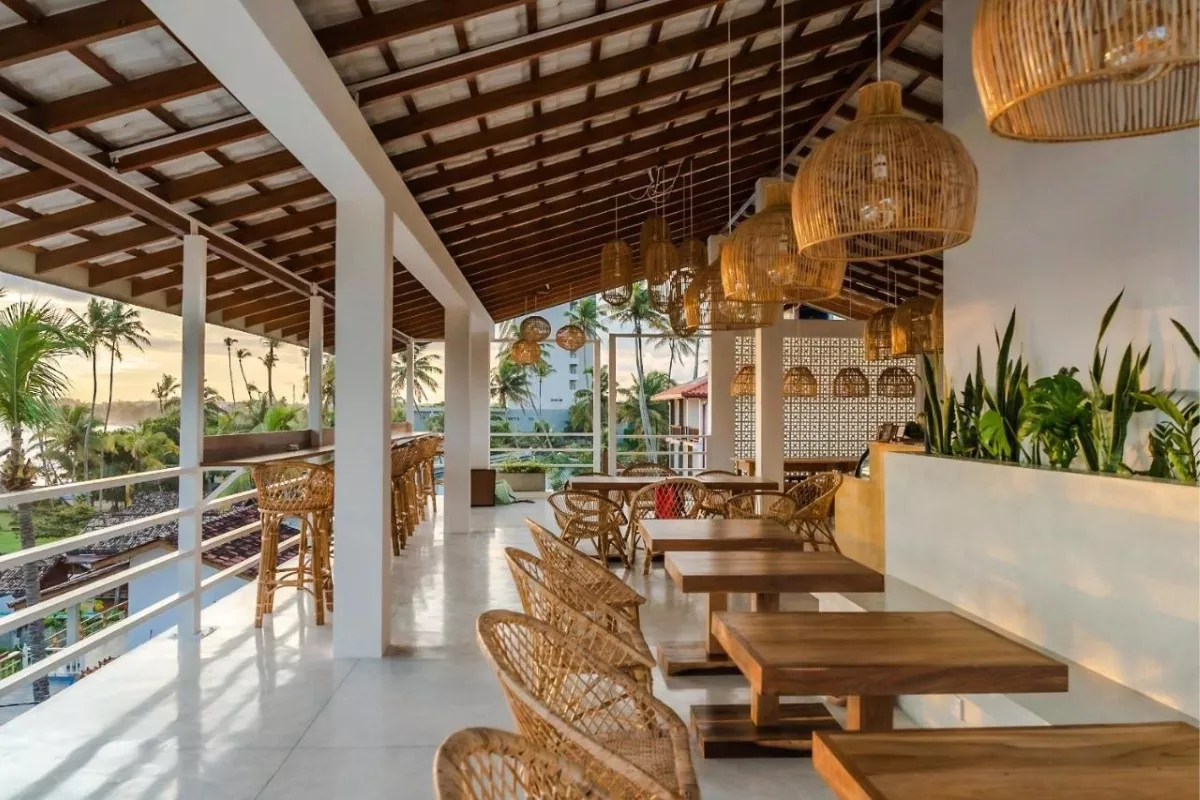
Accomodation in Ahangama, Weligama, and Mirissa
Below we’ve listed out a bunch of different coliving spaces, budget-friendly hostels, and affordable hotels in Ahangama, Weligama, and Mirissa so you can pick your preferred style of accommodation!
Coliving spaces
Outpost Coliving (Weligama) – Beachfront, yoga, and a nice coworking area. Basically, everything you need if you’re looking for a super nice coliving.
Colive Ahangama – Beautiful coliving with free bikes, an outdoor swimming pool, desks inside every room, as well as a coworking space. Awesome place to stay as a nomad!
Budget-friendly hostels
Sugar Hostel Weligama – This hostel in Weligama is actually designed for digital nomads with a community atmosphere and coworking spaces. Great if you’re looking for a hostel option and want to be surrounded by other nomads.
Hangtime Hostel – One of the highlights of Hangtime is the rooftop cafe, which is one of the coworking spots at the hostel. It’s very much a chill backpacker and remote worker vibe. They have everything from live music to game nights and all sorts of other fun community stuff.
JJ’s Hostel (Mirissa) – While this isn’t a digital nomad hostel as such, we did stay here for 3 nights and it was awesome. One of the top-rated hostels in Mirissa and just a short walk from a bunch of laptop-friendly cafés.
Mid-range hotels
The Beach House by Reveal (Mirissa) – Like many modern properties in Sri Lanka this hotel has a super stylish design, outdoor pool, and terrace. You’ll be able to work from the hotel or make your way to one of the local cafes if you want an alternative option!
Mandara Resort (Weligama & Mirissa) – Mandara Resort is actually located between Weligama & Mirissa, so it’s in a great location if you want to experience both towns. It’s super close to the beach and really nice rooms if you’re looking to get some work done in a quiet space.
Long-term rentals
One of the best things you can do for long-term rentals is to pre-book a place for a week or so to get a feel for the area – then book something more long-term.
Once you know the area, feel free to go to the hostels and colivings, and talk to the places directly to see if you can negotiate the price a little bit (or at least get a more local price) than booking directly online.
Hiriketiya (chill surf vibes and growing nomad scene)

Things to do in Hiriketiya
Hiriketiya is another popular area for travellers and digital nomads in Sri Lanka. I would say it’s already quite developed, but still a bit less visited than some of the popular spots around the island.
One of the reasons people love this area is because it’s more peaceful and chill compared to the more touristy places.
You still have amazing beaches, cafes, and jungle vibes. It’s the perfect place to go if you’re looking for some work-life balance!
Accomodation in Hiriketiya
Coliving spaces
Homebase Hiriketiya – It doesn’t get more Sri Lanka than this… a typical two-story house with 7 bedrooms and shared kitchens. It really goes with the chill vibe of this part of the island, where you’ll have other people in the house, but it will always be a relatively small group since there are only 7 rooms.
Chilli Croc Co-Living Hiriketiya – You’ll get the vibe of Hiriketiya quite quickly, and Chilli Croc is a perfect example of that. This coliving is located on a quiet street where you’ll have a nice communal area and garden area to do productive work. Like most colivings, it’s very community-driven and a great place to go if you’re looking to meet other remote workers in Sri Lanka.
Clics Coliving and Coworking – Clics is a coliving, but it’s more hostel vibe inspired with shared rooms and shared community spaces. It’s located close to the beach, so you’ll get a great balance between getting work done while also being close to some fun outdoor activities.
Budget-friendly hostels
Pranaya Hiriketiya – Super awesome hostel within walking distance from the iconic Hiriketiya Beach (the one in the photo above). Pranaya hostel serves an all-day brunch, so you’ll definitely never be hungry. Like everywhere else in the area, it’s a very chilled-out vibe and a great place to get some time to yourself and get some work done.
Happy Hammocks – It doesn’t get much more chill than the name! Typical hostel-style accommodation with incredible reviews, located close to the beach and different communal areas to get work done. They’ve actually got two other locations: In Weligama and Arugam Bay (the next location on this list).
Mid-range hotels:
Jasper House – An awesome hotel in Hiriketiya with ocean views, an infinity pool, and super stylish interior. The beauty of Sri Lanka is that even these mid-range priced accommodations are super nice.
Verse Collective – This is one of the coolest places in the area as it combines a hotel, coworking, and cafe into one. Their slogan is work, surf, skate, create. It’s a great place where you don’t need to go far since a good cup of coffee and a workstation are all under the same roof.
Long-term rentals
Like we mentioned before, maybe book a place for a week or so and then get a feel for the area and where exactly you want to stay. If you love this part of Sri Lanka, you can talk to some other nomads who might have recommendations or even some of the local owners, and go from there.
Arugam Bay (chill surf life)

Things to do in Arugam Bay
Arugam Bay is a traditional surf and party town! It might seem repetitive, but most of these nomad hot spots around Sri Lanka are coastal, so surfing is one of the main things to do in all of these areas.
Even if you don’t surf, it’s still good vibes! You can definitely live a relaxing life over in Arugam Bay, where things move at your own pace.
Accomodation in Arugam Bay
Coliving Spaces
There aren’t many coliving spaces in Arugam Bay yes, but there are a ton of different options for both short and long-term stays.
We’re sure that eventually a coliving will open up – and when it does, we will for sure add it to this list.
Budget-friendly hostels
Wave Hunters – This is one of the best hostels in Arugam Bay for remote workers! It has a dedicated coworking space on the premises which is great. Even though it’s a hostel, the rooms are very boutique styled and well decorated! Of course, it’s a great place to meet people too.
The Long Hostel – Another hostel/coworking vibe set up in a beautiful spot near the bay. Another great hostel that has a very communal vibe. A great spot if you’re looking for a more budget but also community-focused accommodation in Arugam Bay.
Hotels in Arugam Bay
Bay Vista – Great hotel that offers yoga classes, and has comfortable rooms and good amenities. It’s nice that there’s an in-house restaurant and that it’s also within close proximity to the beach!
Jetwing Surf & Safari – If you want to treat yourself, this is the place to stay! Jetwing is a 5-star luxury hotel located right on one of the golden sand beaches of Arugam Bay. They have a beautiful pool, big bungalow rooms, and the wifi is rated 10/10 – so if you don’t get distracted, you can definitely get some work done here!
Cost of Living in Sri Lanka


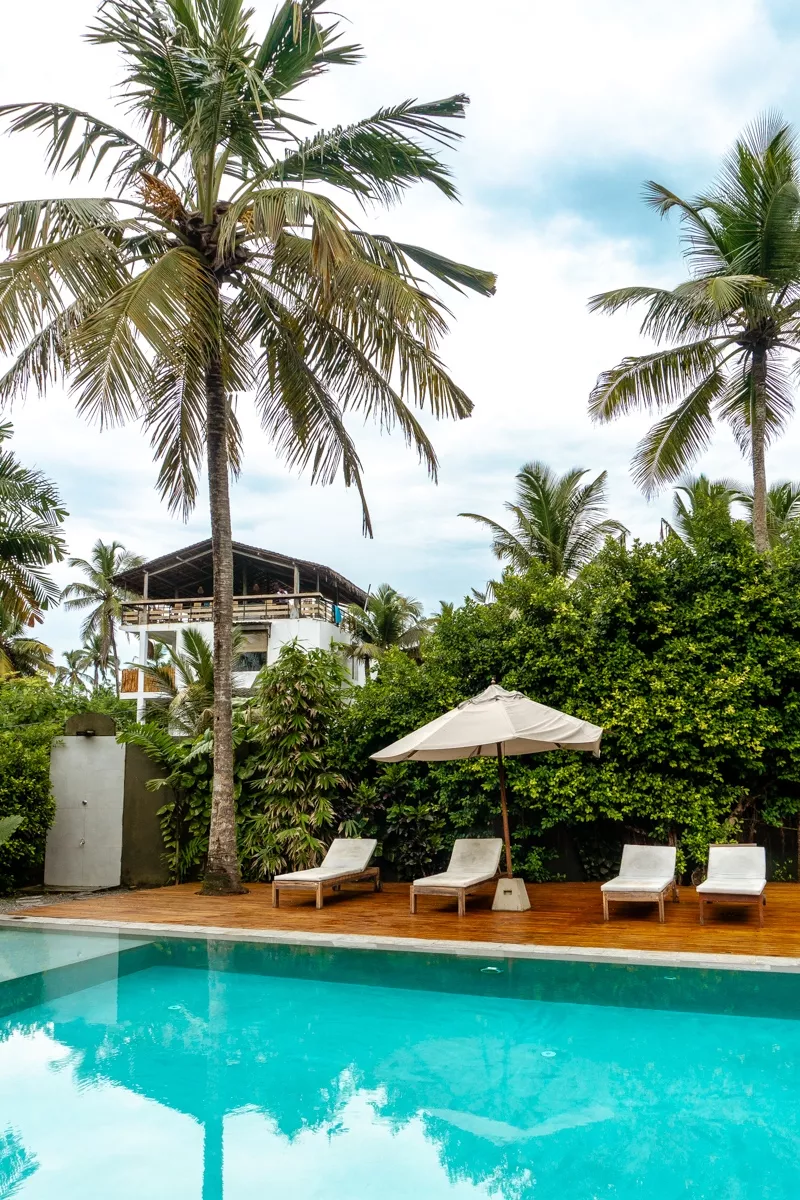
One of the things we get asked about the most as digital nomads is the cost of living in the locations we visit. Having a good estimate of how much it costs to live in Sri Lanka as a digital nomad is going to help you plan your budget and how long you want to stay in the country.
We’ll break up the cost of living into a few categories to give you an idea of how much everything costs. Hopefully, it will give you insight into how much you can expect to spend in a month.
Below, you can find first an overview of the cost of living, and then we’ll break it down to accommodation, food, and transportation.
Under each category, we’ll also give an estimate for different budgets, so you can get a better idea of what exactly living in Sri Lanka would cost you based on your budget and needs.
Total monthly cost estimates for digital nomads in Sri Lanka
So these are the different tiers of cost of living in Sri Lanka based on the type of lifestyle you live. At least it will give you an idea of how much you can expect to pay based on the type of accommodation and maybe how local you’ll eat and drink.
- Budget nomad: $600 – $900 USD a month
- Travel style: hostel, street food, and minimal or local transport
- Mid-range nomad: $1,000 – $1,800 USD a month
- Travel style: private room, coworking, mix of local & western food, scooter rental or tuk-tuks
- Luxury nomad: $2,000 – $3,500+ USD a month
- Travel style: beachfront villa, fine dining, private transport, coworking spaces, gym membership
As we mentioned before, Sri Lanka is an affordable destination, but as with anywhere, the cost of living depends on your lifestyle.
If you eat locally, rent a basic apartment, and avoid luxury stays, you can easily live under $1,000 a month, which is pretty good if you ask me. It can also become a lot more expensive.
Let’s break down the different types of expenses below: accommodation, food, coworking spaces & eSIMs, and transportation.
Accommodation Costs (Monthly)
- Budget (Local Guesthouses & Hostels): $200 – $500
- Mid-Range (Apartments, Villas, Boutique Hotels): $500 – $1,200
- Luxury (Beachfront Villas, Resorts): $1,500+
Most nomads we met rented private rooms in guesthouses or in coliving spaces for around $400-$800 USD a month.
These were all in the popular and touristy places mentioned in this post, such as Weligama, Mirissa, and Hiriketiya.
Going out for food and drinks
- Local meals (Rice & Curry, Kottu Roti, Hoppers, Roti, etc.): $3 – $5 per meal
- Western meals in cafés/restaurants: $5 – $12 per meal
- Groceries (for those who cook at home): $100 – $300 per month
- Coffee (specialty cafés for digital nomads): $3 – $6 per cup
- Beer at a beach bar: $2 – $4
One of the easiest ways to save a lot of money in Sri Lanka is by eating locally. It is super affordable and tastes amazing!
If you mix in Western food and café culture, the costs will jump up very quickly. We’ve had local meal buffets in Sri Lanka that were cheaper than our coffees at a Western-owned café!
Coworking Spaces & eSIMs
Coworking space membership: $50 – $150 a month
If you end up staying at a coliving, it will most likely have a coworking area. There are also tons of great cafes that are perfect for coworking.
So a coworking space is an expense you can cut if you’re on a tight budget. However, they are great for productivity, reliable internet, and connecting with other nomads.
Mobile data & SIM card (Airalo or Nomad): Starting at $6.5 a month
Personally, we only get eSIMs now as they are so much more practical and save you a bunch of time. Also, this way we don’t have to remember where we put our normal sim cards.
eSIMs used to be more expensive, but these days, they are competitive in price with getting a regular sim.
There are a bunch of different providers, but we’ve found Airalo or Nomad to be the most reliable and easiest to use. We’ve used them both before, and they are both great!
Transportation

- Scooter rental: $50 – $100/month
- Fuel for scooter: ~$5 – $10 per month (very cheap)
- Tuk-tuk rides (short distances): $1 – $3 per ride
- Bus fare (long distances like Colombo to Weligama): $2 – $5
- Train ticket (Colombo to Ella 1st class): ~$10
Personally, tuk-tuks became our go-to ride around Sri Lanka. You can find them absolutely everywhere, and they are very cheap to get from A to B.
We’d use them to go to and from cafes, head to the beach to surf, etc!
We also took the train from Ahangama to Galle on a day trip to explore the cute town. We decided to book a 2nd class ticket to get more of a local experience, and it was super fun and very affordable.
So that’s also an option if you’re staying near the train or are going a longer distance!
Digital nomad community and network events
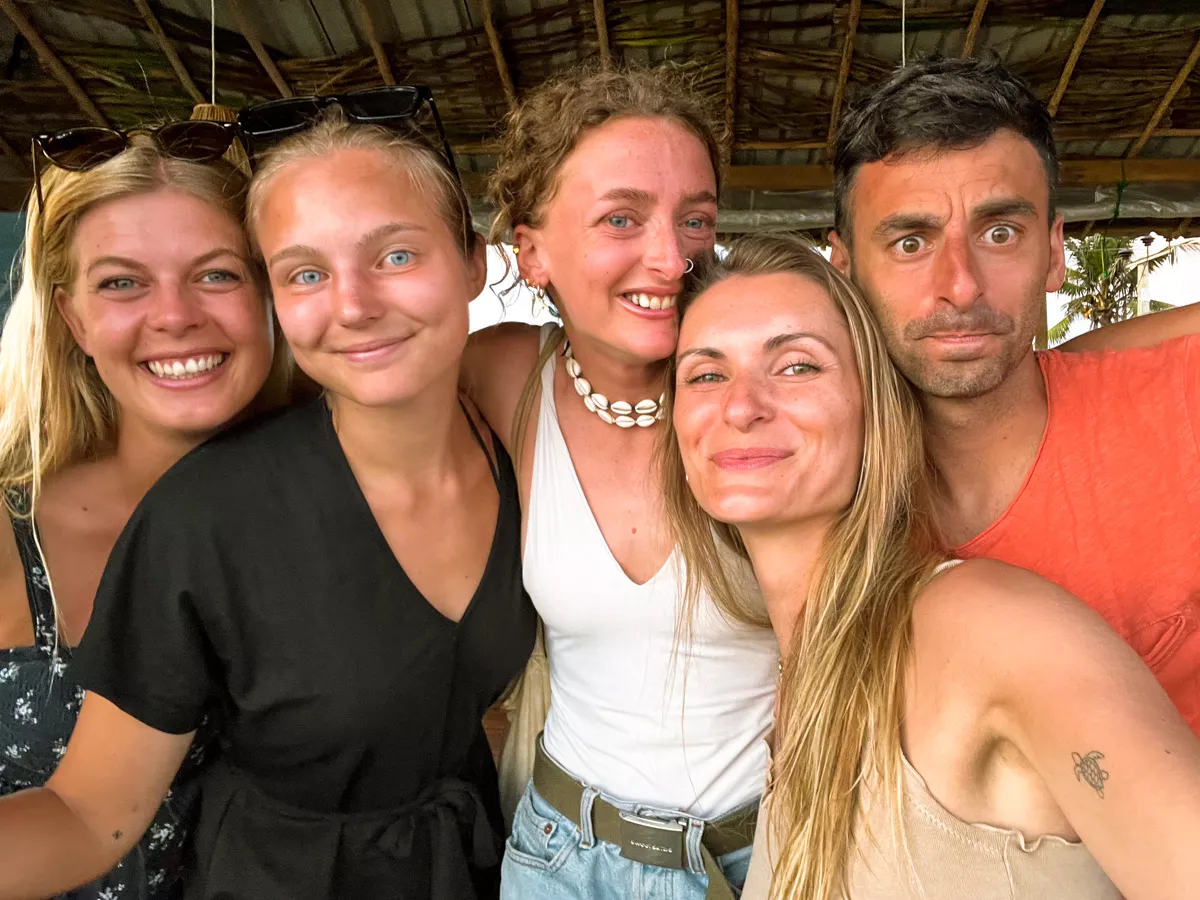
Community and network also play a factor in deciding where to travel to. Usually, the way we decide on our next destination is by asking friends about the places they’ve been that had a good community.
In our case, for Sri Lanka, we actually went specifically for the surf camp, so it’s a slightly different situation than if we had gone only for nomading – but that was a great way to find community!
But in other situations, if we don’t have any recommendations from friends and just want to visit a country, we like to book a coliving so that we know there’s a community, events set up, good infrastructure to work from, etc.
Another thing you can do before arriving in a destination is join some of the local Facebook Groups. Digital Nomads Sri Lanka and Sri Lanka Travel Tips & Advice are two good options.
That way, you can read what people are suggesting and also ask some questions before arriving + get a good feel for the areas you’re thinking of visiting.
You may also like…
Recap of digital nomad life in Sri Lanka

Hopefully, that gave you a better insight into what it’s like being a digital nomad in Sri Lanka. There’s plenty to do, lots of cool areas to stay in, great digital nomad communities, and you can make it as cheap or luxurious as you want it to be.
Sri Lanka is a beautiful country that has so much to offer, with some really cool nomad hotspots you can explore and spend time in. We’re sure you’ll find your own little pocket of the island that you love!
If you have questions about the digital nomad scene in Sri Lanka, what to do, travel insurance, or anything else related to your visit, feel free to reach out. You can catch us on Instagram @redwhiteadventures or leave a comment on this post.
We always love helping people, so if there’s anything you need, don’t hesitate to ask. We hope you enjoy this little surf paradise country in the Indian Ocean as much as we did!
📍 Save this post for later & share it with a friend






